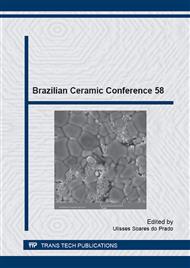[1]
Brazilian Service of Support to Micro and Small Enterprises in the State of Rio de Janeiro, Sebrae-RJ, Local Productive Cluster of Ceramic Insdustries in the Northern Region of the State of Rio de Janeiro – APL, (2006).
Google Scholar
[2]
S.N. Monteiro, C.M.F. Vieira: Tile & Brick Int. Vol. 18 (2002), p.152.
Google Scholar
[3]
S.N. Monteiro, C.M.F. Vieira: Applied Clay Science Vol. 27 (2004), p.229.
Google Scholar
[4]
C.M.F. Vieira, S.N. Monteiro: Materials Science Forum Vols. 727-728 (2012), p.965.
Google Scholar
[5]
L.G. Pedroti, S.N. Monteiro, C.M.F. Vieira, J. Alexandre, A.Z. Destafan, G.C. Xavier: Mater. Sci. Forum Vols. 727-728 (2012), p.619.
Google Scholar
[6]
L.G. Pedroti, S.N. Monteiro, C.M.F. Vieira, J. Alexandre: Mater. Sci. Forum Vols 727-728 (2012), p.809.
Google Scholar
[7]
M.C. Aguiar, M.C.B. Gadioli, M.P. Babisk, V.S. Candido, S.N. Monteiro, C.M.F. Vieira: Mater. Sci. Forum Vols. 798-799 (2014), p.251.
Google Scholar
[8]
G.C. Xavier, J. Alexandre, P.C.A. Maia, F.S. Albuquerque Jr., L.G. Pedroti, A.R.G. Azevedo, S.N. Monteiro: Mater. Sci. Forum 798-799 (2014), p.269.
Google Scholar
[9]
A.R.G. Azevedo, J. Alexandre, G.C. Xavier, E.B. Zanelato, V.S. Candido, S.N. Monteiro: Mater. Sci. Forum: Vols. 798-799 (2014), p.481.
Google Scholar
[10]
A. Carvalho: Mater. Sci. Forum Vols 798-799 (2014), p.548.
Google Scholar
[11]
. A.R.G. Azevedo, J. Alexandre, G.C. Xavier, V.S. Candido, S.N. Monteiro, C.M.F. Vieira: Mater. Sci. Forum Vols. 798-799 (2014), p.638.
Google Scholar
[12]
Brazilian Association of Technical Norms. Soil - Granulometric Analysis. Rio de Janeiro: ABNT 1988. (NBR-7181). (In Portuguese).
Google Scholar
[13]
American Society for Testing and Materials - ASTM C 373-372, Water absorption, bulk density, apparent porosity and apparent specific gravity of fired whiteware products, USA, (1972).
DOI: 10.1520/c0373-14
Google Scholar
[14]
American Society for Testing and Materials – ASTM C 674-677, Flexural properties of ceramic witheware materials, USA, (1977).
Google Scholar
[15]
W.D. Kingery: Introduction to Ceramics. (John Wiley & Sons New York, 1975).
Google Scholar
[16]
Brazilian Association for Technical Norms. Ceramic components - Ceramic roof tiles – Terminology requirements and testing methods. Rio de Janeiro: ABNT 2009. (NBR-15310). (In Portuguese).
Google Scholar
[17]
Brazilian Association for Technical Norms. Ceramic components Part 1: Hollow ceramic blocks for non load-bearing masonry - Terminology and requirements Rio de Janeiro: ABNT 2005. (NBR-15270-1). (In Portuguese).
Google Scholar


